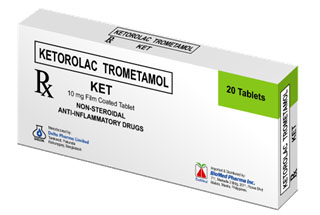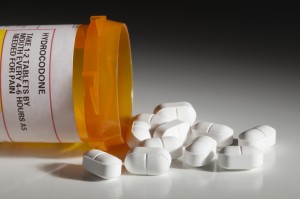Contents
What is Ketorolac
Ketorolac is a Generic name for a non-steroidal anti-inflammatory drug (NSAID) with pyrrolizine structure containing salt ketorolac tromethamine as an active ingredient, that is used as an anti-inflammatory agent with analgesic and antipyretic properties for the management of osteoarthritis and moderately severe acute pain that needs analgesia at the opioid level, usually in a postoperative patients.
It is a peripherally acting analgesic. Ketorolac is available in a form of solution and injection for intramuscular route in doses of 15 mg/ml and 30 mg/ml, as an ophthalmic solution in doses of 4, 4.5 and 5 mg/ml, as and intravenous solution in doses of 15, 30 and 60 mg/ml and as a film coated tablet in the dose of 10 mg.
Ketorolac tromethamine in tablet and intramuscular dosage forms is a racemic mixture of both (S)-(−)-ketorolac, the active isomer with analgesic properties, and (R)-(+)-ketorolac.
An ophthalmic solution is used to treat eye pain and to relieve the burning and itchiness caused by seasonal allergies. It is usually taken every 4 to 6 hours on a schedule or as needed for pain.
Common Brand names on the market containing ketorolac tromethamine as an active ingredient are: Bedoral, Dolten, Emodol, Etorac, Ketora, Ketonic, Syndol, Lixidol, Toradol and Tarasyn.
What is Hydrocodone
Hydrocodone is a Generic name for an opioid drug which is synthesized from codeine, an opioid alkaloid that can be found in the opium poppy.
This drug is narcotic analgesic which is used orally for relieving the moderate to severe pain, but it is also commonly used in liquid form as an antitussive agent for symptomatic relief of nonproductive cough, alone or together with other cough suppressants or expectorants.
This drug works by changing the way the brain and nervous system respond to pain. As an analgesic, hydrocodone is usually combined with ibuprofen, acetaminophen or aspirin for pain treatment.
The analgesic action of hydrocodone starts in 20–30 minutes and lasts for about 4–8 hours. However, hydrocodone is only used for the treatment of patients who are expected to need painkiller for severe pain for a long time, and who cannot be treated with other medicines or treatments.
Hydrocodone is predominantly prescribed in the US. According to the the International Narcotics Control Board, 99% of the worldwide hydrocone supply in 2007 was consumed in the US.
Other Brand names on the market containing hydrocodone are: Hysingla ER, Zohydro ER, Norco, Vicodin and Robidone.
How does Ketorolac and Hydrocodone work in the body
Ketorolac tromethamine is a racemic mixture of [+]R- and [-]S- enantiomers, with the S-form containing analgesic activity. This drug works by inhibiting both cyclooxygenase enzyme, COX-1 and COX-2, leading to the inhibition of prostaglandin synthesis, decreased formation of precursors of prostaglandins and thromboxanes.
Analgesic effects are probably produced through peripheral action in which impulse signaling blockage results from decreased prostaglandin activity.
However, analgesic effects may be also contributed through the inhibition of actions or synthesis of other body substances that can sensitize receptors responsible for pain due to mechanical or chemical stimulation. After ocular administration, ketorolac reduces prostaglandin E2 levels in aqueous humor, secondary to inhibition of prostaglandin biosynthesis.
Hydrocodone is an opioid agonist of opioid receptors within the CNS. This morphinans structure substance blocks pain perception in the cerebral cortex of the brain.
Hydrocodone decreases synaptic chemical transmission in the CNS, which in turn inhibits pain sensation into the higher centers of the brain. Agonist activities at the μ and kappa receptors can cause analgesia, miosis, and decreased body temperature.
Agonist activity at the μ receptor can also cause the suppression of opiate withdrawal, while antagonist activity can result in precipitation of withdrawal.
Hydrocodone acts at several locations within the CNS by involving several systems of neurotransmitters to produce analgesia, but the precise mechanism of action has not been fully understood.
Opiate agonists don’t change the threshold or responsiveness of afferent nerve endings to noxious stimuli nor the conduction of impulses along peripheral nerves.
Instead, they alter the perception of pain at the spinal cord and higher concentrations in the CNS and the person’s emotional response to pain.
Hydrocodone can produce inhibition at the chemoreceptors through μ-opioid receptors and in the medulla through μ and δ receptors which can lead to dose-related respiratory depression.
Can patients take Ketorolac and Hydrocodone together
Ketorolac and Hydrocodone are commonly used together for the treatment of acute severe pain, and they are often prescribed for a short-term administration.
They have different mechanisms of action and have no significant pharmacological interactions in the body.
However, patients should not use this combination for more than 5 days, because Ketorolac can cause serious gastrointestinal side effects such as GI bleeding and ulcers and also kidney problems in predisposed patients while hydrocodone can cause prolonged constipation.
If these side effects occur, patients should stop using them and call their doctor immediately.
The table below shows side effects after Hydrocodone and Ketoralac administration in recommendable doses. The incidence can be significantly increased if these drugs are overdosed or taken together.
| Very common side effects >10%
|
Headache (17%), Constipation (8-11%), Somnolence (3-14%), Dyspepsia (12-13%), GI pain (12-13%), Nausea (12-13%) |
| Common side effects 1-10% | Vomiting (3-5%), UTI (1-5%), Dry mouth (3%), Pruritus (3%), Hypertension (4%) Tremor (3%), Fatigue (1-4%), Back pain (1-4%), Dizziness (3-9%), Peripheral edema (1-3%), Pruritus (3-9%), URI infection (1-3%) and Muscle spasms (1-3%), Decreased appetite (2%), Tinnitus (2%), Insomnia (3%), Influenza (3%), Diarrhea (3-9%), Increased blood urea nitrogen (BUN) (3%), Purpura (<3%). Increased serum creatinine (2%) |
Special precautions and warnings during Ketorolac and Hydrocodone administration:
- Patients should tell their doctor and pharmacist if they are allergic to ketorolac or hydrocodone, or any other medicines, or any of the ingredients that are used in the production of hydrocodone extended-release capsules or extended-release tablets.
- Patients should tell their doctors or pharmacists what prescription and nonprescription medicines, vitamins or nutritional supplements they are taking or plan to take while taking these drugs.
- Patients administrating hydrocodone should also tell their doctors if they are using any of the following medications: antihistamines; dronedarone (Multaq); medications for irritable bowel disease, Parkinson’s disease, ulcers, haloperidol (Haldol); azithromycin (Zithromax, Zmax); amiodarone (Cordarone, Pacerone, Nexterone); butorphanol;chlorpromazine; citalopram (Celexa); laxatives such as lactulose (Cholac, Constulose, Enulose, others); nalbuphine; or pentazocine (Talwin), levofloxacin (Levaquin).They should also tell their doctors if they are taking the following medications or have stopped taking them within the past two weeks: isocarboxazid (Marplan), selegiline (Eldepryl, Emsam, Zelapar), phenelzine (Nardil), rasagiline (Azilect), or tranylcypromine (Parnate). Doctor may need to change the doses of medicines or monitor carefully for side effects.
- Hydrocodone shouldn’t be used if patient has blockage of stomach or intestines, or paralytic ileus.
- Patients should tell their doctor if they have or have ever had hypotension, difficulties with urinating, seizure attacks, or any of the thyroid, liver, kidney, gall bladder or pancreas disease.
- Patients should tell their doctor if they are breastfeeding.
- If patients are having surgery, including dental surgery, they should tell their doctor or dentist that they are taking hydrocodone or ketorolac.
- Hydrocodone may make patients drowsy. Patients taking hydrocodone should not drive a car or operate machinery.
- Hydrocodone may cause dizziness, fainting and lightheadedness, if patient get up too quickly from a lying position. This is more common when initial dose of hydrocodone is taken. To avoid this problem, patients should slowly get out of bed, resting their feet on the floor for a few minutes before standing up.
- Hydrocodone can cause constipation. Patients should talk with their doctor about changing diet and using other medications to treat or prevent constipation
- Patient should not take Ketorolac if they are already using Probenecid. They should also tell their doctor or pharmacists if they are using some of the following drugs: medications for anxiety or mental illness; antidepressants; , methotrexate (Rheumatrex); medications for seizures such as carbamazepine or phenytoinsedatives; sleeping pills; and tranquilizers. Doctor may need to change the doses of medicines or monitor carefully for side effects.
- Ketorolac shouldn’t be used for more than 5 days, because it can cause gastrointestinal side effects.
- Patients using Ketorolac should tell their doctor if they have or have ever had: swelling of the hands, ankles, lower legs or feet.
- Women on Ketorolac therapy should tell their doctor if they are pregnant, especially if they are in the last trimester of their pregnancy, or if they plan to become pregnant. If they become pregnant while taking ketorolac, they should call their doctor.
- Older adults (65 or older) should not usually take ketorolac because it is not as safe as other drugs that can be used to treat the same conditions.
- Ketorolac may make patients drowsy or dizzy. They shouldn’t drive a car or operate machinery while using this medicine
- Alcohol can make the side effects of ketorolac worse and increase the incidence of side effects.
“Can you take Hydrocodone and Meloxicam together“
“How does aspirin help prevent heart attacks“


